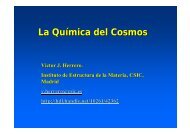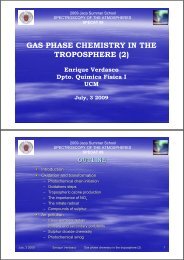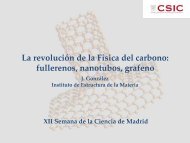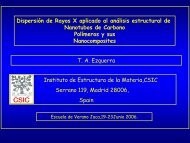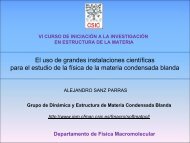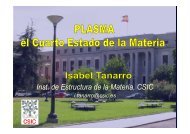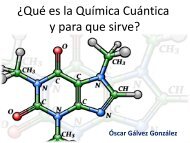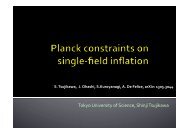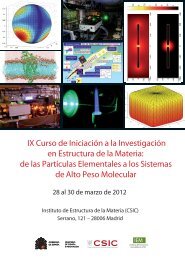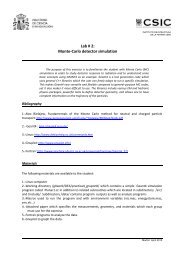We have investigated transport through ballistic quantum dots in the Coulomb blocka<strong>de</strong> regime. We have shownthrough theoretical arguments based on the shape of the wave functions of chaotic quantum system and numericalcalcu<strong>la</strong>tions, the emergence of long universal sequences of resonances and phase <strong>la</strong>pses in the short wavelengthlimit. Our results are in qualitative agreement with experiments on Aharanov-Bohm interferometry. Moreover, ourresults predict the dissapearance of the observed universal regime in the presence of strong magnetic fields and in<strong>la</strong>rger quantum dots in the diffusive regime.CONTINUUM THREE-BODY WAVE FUNCTIONS: RESONANCES, DECAY MODES, ANDREACTIONSGenerally speaking, our main goal is contribute to the <strong>de</strong>velopment of the different techniques that permit toinvestigate three-body systems, and to exploit them to study the structure and properties of light nuclei. A propertreatment of the long distance behaviour of the three-body wave function is essential to un<strong>de</strong>rstand how theresonances of systems like 12 C or 9 Be do actually <strong>de</strong>cay. Another important topic un<strong>de</strong>r investigation is the lowenergynuclear reactions involving these nuclei. An important group of them are the radiative capture processes,which p<strong>la</strong>y a very important role in the stel<strong>la</strong>r nucleosynthesis processes, in particu<strong>la</strong>r, in bridging the waitingpoints. We also investigate pure nuclear reactions, in particu<strong>la</strong>r the ones corresponding to a two-body projectilehitting a target. We exploit the particu<strong>la</strong>rities of the adiabatic potentials to distinguish in a clean way between thedifferent channels (e<strong>la</strong>stic, ine<strong>la</strong>stic or rearrangement).More specifically, during the <strong>la</strong>st months our work has been focused in two main issues: The first one concerns thetriple-alpha process and its reaction rate at very low temperatures. The fact that at such low temperatures theenergies involved are far below the lowest 0 + resonance in 8 Be implies that a sequential <strong>de</strong>scription through thatparticu<strong>la</strong>r two-body resonance is not obvious. In fact we have found that a direct capture <strong>de</strong>scription of the process,without popu<strong>la</strong>ting any intermediate two-body state, could increase the reaction rate by up to 7 or<strong>de</strong>rs of magnitu<strong>de</strong>for a temperature of 10 7 GK. The second main topic refers to the <strong>de</strong>scription of 1+2 reactions by use of the recently<strong>de</strong>rived two integral re<strong>la</strong>tions. We have found the method to be very successfull to <strong>de</strong>scribe processes below thetwo-body breakup threshold, not only for e<strong>la</strong>stic processes, but also for ine<strong>la</strong>stic and transfer reactions. Applicationof the same method for energies above the breakup threshold is the next step. In this connection, very promising andpreliminary results have recently been obtained.STELLAR WEAK DECAY RATES FOR THE rp PROCESSWeak <strong>de</strong>cay rates un<strong>de</strong>r stel<strong>la</strong>r <strong>de</strong>nsity and temperature conditions holding at the rapid proton-capture process hasbeen studied in neutron-<strong>de</strong>ficient medium-mass waiting-point nuclei extending from Ni up to Sn. Neighboringisotopes to these waiting-point nuclei are also inclu<strong>de</strong>d in the analysis. The nuclear structure part of the problem is<strong>de</strong>scribed within a <strong>de</strong>formed Skyrme Hartree-Fock + BCS + quasiparticle random-phase-approximation approach,which reproduces not only the β-<strong>de</strong>cay half-lives but also the avai<strong>la</strong>ble Gamow-Teller strength distributionsmeasured un<strong>de</strong>r terrestrial conditions. The various sensitivities of the <strong>de</strong>cay rates to both <strong>de</strong>nsity (ρ) and temperature(T) have been discussed.There are several distinctions between terrestrial and stel<strong>la</strong>r <strong>de</strong>cay rates caused by the effects of high ρand T. Themain effect of T is directly re<strong>la</strong>ted to the thermal popu<strong>la</strong>tion of excited states in the <strong>de</strong>caying nucleus, accompaniedby the corresponding <strong>de</strong>popu<strong>la</strong>tion of the ground states. The weak <strong>de</strong>cay rates of excited states can be significantlydifferent from those of the ground state, and a case-by-case consi<strong>de</strong>ration is nee<strong>de</strong>d. Another new effect comes fromthe fact that atoms in these scenarios are completely ionized, and consequently, electrons are no longer bound to thenuclei but form p<strong>la</strong>sma obeying a Fermi-Dirac distribution. This opens the possibility for continuum electroncapture, in contrast to the orbital electron capture produced by bound electrons in an atom un<strong>de</strong>r terrestrialconditions. Thus, we have studied the <strong>de</strong>cay of the ground and excited states in the parent nucleus by introducing apartition function and statistical weights, as well as the competition between β<strong>de</strong>cays and continuum electroncaptures. We find a non-negligible contribution from the <strong>de</strong>cay of excited states, which is <strong>la</strong>rger for low-lyingexcited states. We also find that contributions from continuum electron captures are comparable to those from beta<strong>de</strong>cayfor waiting-point nuclei at the rp-conditions. These contributions are usually neglected in present networkcalcu<strong>la</strong>tions.SHAPE TRANSITIONS IN NEUTRON-RICH ISOTOPESThe study of the nuclear shape evolution as the number of nucleons changes is nowadays a highly topical issue innuclear physics from both theoretical and experimental points of view. Especially interesting are those situationswhere the nuclear structure suffers drastic changes between neighbor nucli<strong>de</strong>s. This is the case of the neutron-richisotopes with masses around A=100. These structural variations lead often to sud<strong>de</strong>n changes of particu<strong>la</strong>r nuclearproperties that can be used as signatures of phase/shape transitions.52
We have studied the bulk and spectroscopic properties of neutron-rich even-even and odd-A isotopes in this massregion within the selfconsistent Hartree-Fock-Bogoliubov approximation based on the finite range and <strong>de</strong>nsity<strong>de</strong>pen<strong>de</strong>nt Gogny energy <strong>de</strong>nsity functional (EDF). In addition to the well known D1S parametrization of theGogny-EDF, we also consi<strong>de</strong>r the most recent parametrization D1M. From this comparison we evaluate not only therobustness of our results, but we also explore the capability of D1M to account for the phenomenology of odd-Anuclei, not so well studied yet. The <strong>de</strong>scription of the odd-A nuclei is done in terms of the equal fillingapproximation, a prescription wi<strong>de</strong>ly used in mean-field calcu<strong>la</strong>tions to preserve the advantages of time-reversalinvariance. We have analyzed various nuclear properties, such as two-neutron separation energies, charge radii, andthe spin-parity of ground states in a search for signatures of shape transitions. In several isotopic chains we havefound clear signatures of a sharp shape transition at N=60 in both charge radii and spin-parity of the ground states,which are robust, consistent to each other, and in agreement with experiment. In other isotopic chains the shapetransition disappears, stabilizing one of the shapes or <strong>de</strong>veloping triaxial <strong>de</strong>formations. We point out that thecombined analysis of these two observables could be used to predict unambiguously new regions where shapetransitions might <strong>de</strong>velop.THEORETICAL PHYSICAL-CHEMISTRY APPLIED TO ASTROPHYSICSDuring <strong>2011</strong>, we have performed molecu<strong>la</strong>r studies within the three sub-lines of research carried out by our group:molecu<strong>la</strong>r spectroscopy of prebiotic non-rigid molecules of astrophysical interest; structural and spectroscopiccharacterization of semi-rigid species of astrophysics and atmospheric importance and <strong>de</strong>termination of crosssections in non reactive ine<strong>la</strong>stic collisions at very low temperatures. In all these works, high-level ab initiocalcu<strong>la</strong>tions are used as a basic tool to <strong>de</strong>termine potential energy surfaces and molecu<strong>la</strong>r structures. From thesemethods and with our ro-vibracional co<strong>de</strong>s ENEDIM and FIT-SPEC we predicted many spectroscopic properties.Molecules and the problems addressed are relevant to the study of the gas phase chemistry of the interstel<strong>la</strong>r andcircuneste<strong>la</strong>r media and p<strong>la</strong>netary atmospheres. Research carried out within the scientific exploitation of newobservatories Herschel and ALMA programs.In recent years, we have been <strong>de</strong>veloping very <strong>de</strong>tailed studies focused to the characterization of carbon-chains ofastrophysical importance. Carbon-chains are relevant iso<strong>la</strong>ted species as well as important intermediates offormation processes of <strong>la</strong>rge molecules such as the PAHs and Fullerenes. We have studied with very precisemethods small size chains that are re<strong>la</strong>tively abundant in carbon rich sources. We initiated the sequence by purechains type C n with a reduced number of atoms (n) and likely to be <strong>de</strong>tected with infrared techniques using theinstruments of the new Herschel Space Observatory. Currently, we are studying neutral and charged chains typeC n X m (X = Si, S or H) and type SiNH n . These species, which are difficult to be treated at the <strong>la</strong>boratory level for itslow stability, have permanent dipole moment and are therefore <strong>de</strong>tectable through radio astronomy. They aretherefore relevant species with a view to the future project ALMA. We provi<strong>de</strong>d special attention to the anions dueto the recent interest awaken in the astrophysical community, studying C 4 H - (<strong>de</strong>tected by IEM astronomers) andanions type SiC n and SiC n H. We have i<strong>de</strong>ntified isomeric structures, potential energy surfaces for the first electronicstates, as well as rovibrational properties including anharmonicity effects. We provi<strong>de</strong> possible isomerizationprocesses and predict Renner-Teller and rovibronic effects.For the ALMA project science exploitation, it is necessary to un<strong>de</strong>rstand the millimeter and sub-millimeter spectraof non-rigid molecules containing the most abundant interstel<strong>la</strong>r elements C, N, O and H. Many of these moleculesare c<strong>la</strong>ssified as prebiotic. They show very low energy vibrational levels that can be popu<strong>la</strong>ted at very lowtemperatures. These levels correspond to the <strong>la</strong>rge amplitu<strong>de</strong> vibrations that inter-transform minimum energystructures through feasible potential energy barriers. Given the astrophysical interest, we are studying with veryprecise initio method the torsional and bending mo<strong>de</strong>s of dimethyl-ether and methyl format. Recently, UREA has53
- Page 3: INTRODUCCIÓNEl Instituto de Estruc
- Page 10 and 11: Dra. Maria Esperanza Cagiao Escohot
- Page 12 and 13: TALLER ÓPTICOD. José Lasvignes Pa
- Page 14 and 15: 2A.1 DPTO. DEQUÍMICA YFÍSICA TEÓ
- Page 16: empezar a caer. Este fenómeno se e
- Page 19 and 20: Existen varias diferencias entre la
- Page 21 and 22: Estudio de las propiedades estructu
- Page 23 and 24: poblar los estados de interés en 1
- Page 25 and 26: Si bien la técnica TF está bien e
- Page 27 and 28: que no se produzca la ruptura de en
- Page 30 and 31: antitumoral emodina mediante el efe
- Page 32 and 33: Esta formulación ha sido desarroll
- Page 34 and 35: oooooCriogenia.Espectroscopía Rama
- Page 36 and 37: FLUIDODINÁMICA MOLECULAREl princip
- Page 38 and 39: También se ha concluido y publicad
- Page 40 and 41: o Análisis mecánico en tracción:
- Page 42 and 43: cuerpo (BCC), tiene lugar la formac
- Page 44 and 45: BIOSAXSCaracterización de coloides
- Page 46 and 47: Sin embargo, desde el punto de vist
- Page 48 and 49: 2B.1 THEORETICAL PHYSICS AND CHEMIS
- Page 50 and 51: terms and that b) stellar pulsation
- Page 54 and 55: een proposed as possible interstell
- Page 56 and 57: The figure shows a compilation of t
- Page 58 and 59: oppositely aligned spins. This pair
- Page 60 and 61: PHYSICAL BEHAVIOR AT NANO-SCALESPro
- Page 62 and 63: done in collaboration with research
- Page 64 and 65: Finally, we have also conducted a w
- Page 66 and 67: species have been obtained from tim
- Page 68 and 69: Rideal mechanism, with a preference
- Page 70 and 71: Liquid hydrogen filament (5 micron
- Page 72 and 73: Nanostructure of polymer thin films
- Page 74 and 75: morphological model for Natural Rub
- Page 76 and 77: product. The clay can be used direc
- Page 78 and 79: with the extracellular ERBBs domain
- Page 80 and 81: 3.1 DPTO. DEQUÍMICA YFÍSICA TEÓR
- Page 82 and 83: Duration: January 2010-December 201
- Page 84 and 85: Objectives: This Project aims at ob
- Page 86 and 87: Funding Institution: Comunidad de M
- Page 89 and 90: CAPÍTULO 4COOPERACIÓN CIENTÍFICA
- Page 91 and 92: 4.1.3 DPTO. DE FÍSICA MOLECULAR /
- Page 93 and 94: o Complete Hybrid Quantization of a
- Page 95 and 96: R3B Collaboration Meeting, Darmstad
- Page 97 and 98: SERS Roundtable 2011, Poltersdorf (
- Page 99 and 100: International Conference on Process
- Page 101 and 102: 4.3. ESTANCIAS DE INVESTIGADORES EN
- Page 103 and 104:
Dr. Francesca Vidotto.Université d
- Page 105 and 106:
4.4.3 DPTO. DE FÍSICA MOLECULAR /
- Page 107:
Guillermo Ribeiro Jiménez. Subatom
- Page 110 and 111:
5.1 DOCENCIA / TEACHING5.1.1 DPTO.
- Page 112 and 113:
5.1.3 DPTO. DE FÍSICA MOLECULAR /
- Page 114 and 115:
5.2.3 DPTO. DE FÍSICA MOLECULAR /
- Page 116 and 117:
Óscar Gálvezo Hielos y Plasmas de
- Page 118 and 119:
Olof Tengblad- Deputy Technical Man
- Page 120 and 121:
5.5 ACTIVIDADES Y MATERIAL DE DIVUL
- Page 122 and 123:
Plasma, el cuarto estado de la mate
- Page 124 and 125:
5.7 UNIDADES ASOCIADAS Y OTRAS ACTI
- Page 126 and 127:
oScientific collaboration on “Din
- Page 128 and 129:
6.1 PUBLICACIONES EN REVISTAS Y PRO
- Page 130 and 131:
Prescriptions in Loop Quantum Cosmo
- Page 132 and 133:
Richardson-Gaudin Models: The Hyper
- Page 134 and 135:
79. L. Guerrini, S. Sanchez-Cortes,
- Page 136 and 137:
Probing the Nature of Particle-Core
- Page 138 and 139:
PROCEEDINGS ISI /ISI PROCEEDINGS120
- Page 140 and 141:
Physical Review Letters 106, 245301
- Page 142 and 143:
Conducting Nanocomposites Based on
- Page 144 and 145:
3. O. S. Kirsebom, S. Hyldegaard, M
- Page 146 and 147:
6.4 TESIS DOCTORALES / Ph. D. THESE
- Page 149 and 150:
CAPÍTULO 7TABLAS Y DATOSCHAPTER 7T
- Page 151 and 152:
Spectrochimica Acta B 2 3.552Chemph
- Page 153 and 154:
7.4 PERSONAL POR DEPARTAMENTOS /PER
- Page 155 and 156:
ÍNDICEINDEX155
- Page 157 and 158:
4.1.2 Dpto. de Espectroscopía Nucl
- Page 159:
6.2.2 Dpto. de Espectroscopía Nucl




